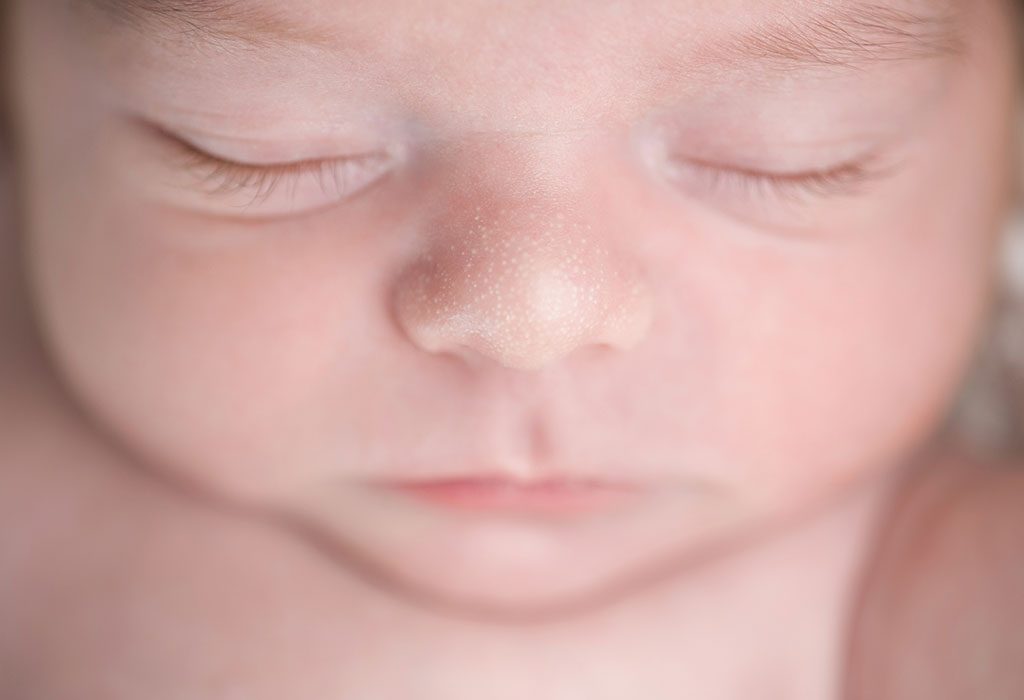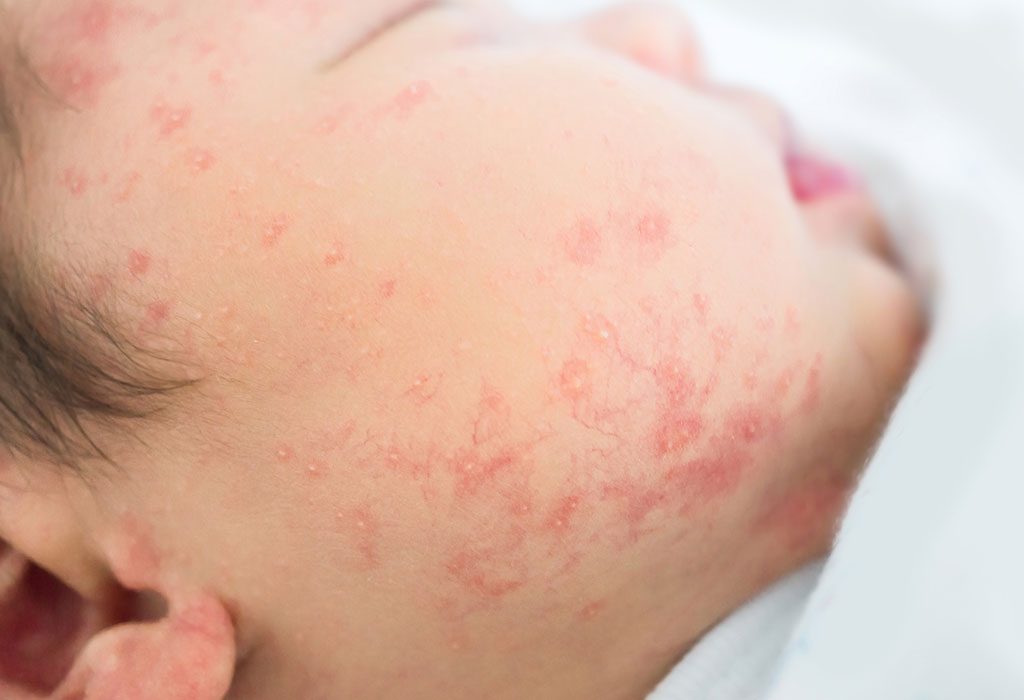In this Article
Babies tend to have extremely soft and smooth skin; which is why, the moment a rash appears on their skin, parents start panicking. If your baby has a rash, it can be troublesome for him. He may start crying and fidget since he can’t express why he is feeling uncomfortable. If your little one has a rash on his face and is crying continuously, as a parent, you should try to help him and understand the different types of rashes so as to know when to seek a professional. Usually, rashes on a baby’s face are harmless and clear up on their own. However, sometimes a rash on a baby’s face could indicate a serious condition. Read on to understand the different types of rashes and how to treat them.
Causes of Rashes on Baby’s Face
As a baby’s skin is sensitive, it is susceptible to rashes or irritation. Here are some of the common causes of rashes on a baby’s face.
1. Food Allergy
Rashes can be a clear-cut reaction to food items that your baby might be allergic to. These items could be transferred to a baby via breast milk as well. If your baby is on supplementary food, certain ingredients of the formula can also trigger an allergy in a baby, and he may develop rashes on the face.
2. Chemical Reaction
Sometimes, a baby may also get a rash if he wears clothes that are not washed properly. The detergents or solutions you use to wash your baby’s clothes, bedsheets or any clothing item that comes in contact with your baby may cause the rash. Similarly, creams, soaps, or perfumes that might be used on the baby or around them, could also trigger similar reactions.
3. Extreme Climatic Conditions
Babies have extremely sensitive skin that immediately reacts to the changes in the surrounding atmosphere. If the air is extremely hot or the AC is turned up too high, the baby’s skin may get dehydrated, causing the rash to appear. External weather conditions could further trigger these, making things difficult for the baby.
4. Poor Hygiene
If your friends and relatives come to your house, they may not always use a sanitiser to clean their hands before taking him in their arms or when playing with him. Holding the baby without washing hands may also cause germs and other particles to come in contact with the baby’s sensitive skin, causing reactions. In case a rash has just disappeared, the presence of germs could cause it to appear again.
If proper cleanliness is not maintained in the house, it could also lead to allergic reactions which may cause a rash to appear. If you don’t clean or disinfect your house or your baby’s toys regularly, the dust particles in the room or on the toys may circulate around the room. If these dust particles are inhaled by the baby or come in contact with his skin, it may cause the rash to appear. These germs could also make your baby ill.
5. Pet Allergies
If you have pets in your home, their presence could also trigger allergies in your baby. Pet hair usually litter around the house and may trigger allergic reactions. If you play with your pet, make sure your hands and body are clear of any saliva or pet hair before you take your baby in your arms.
Types of Rashes
Some of the most common types of baby rashes are mentioned below.
1. Infantile Eczema
Infantile eczema also termed as atopic dermatitis, this rash usually appears when rough cloths, chemical detergents, or other skin allergens come into contact with the baby. It looks dry, scaly, and reddish, and generally appears on the face, legs, chest, and arms.
2. Baby Acne
This acne is not as bad as adult acne. The small protruding bumps on the face of a baby that resemble a pimple and are pink in colour, appear due to being exposed to the mother’s hormones. Baby acne may appear just 2 to 4 weeks after the birth of the baby but it usually clears up on its own in about 3 to 4 months and does not leave any marks on the baby’s face.
3. Impetigo
Impetigo is a common skin condition that is contagious. Impetigo appears on a baby’s face, especially around his nose, and on his hands in the form of extremely irritating red-coloured blisters. This condition is extremely contagious and is actually an infection. Doctors usually recommend antibiotic treatment immediately after it is diagnosed.
4. Milia
If you see small white-coloured pinpoint bumps on your baby’s face, these are a clear sign of milia. These are subepidermal cysts. They resolve on their own, hence no treatment is required.

5. Dribble Rash
Usually observed around the area of baby’s mouth, whether on the chin or across the neck, the reason for dribble rash is exactly as the name suggests – the dribbling of saliva excessively from the baby’s mouth. If the saliva isn’t wiped off periodically and stays accumulated in these areas, it results in this kind of a rash.
6. Seborrheic Dermatitis
Observed primarily in areas of the baby’s skin where the hair is present, this can later spread to other areas of the body too. This rash appears in the form of irritating small red bumps and some crusty scales in yellow colour on the scalp, and even within eyebrows and eyelashes. The reason behind this is an allergic reaction to food, primarily through baby formulas or supplementary foods.
7. Slapped Cheek Syndrome
Slapped cheek syndrome is a viral infection that leads to the development of a bright red rash on one or both cheeks. The rash on cheeks usually disappears in a few days’ time, but if the rashes develop on other parts of the body like arms, chest, and legs, it may take some time, about 7-10 days to disappear. Although this rash is more common in school-aged children, anyone could get it. This rash is usually not painful and disappears on its own. However, you should seek medical help if your baby has it for a long time now.
7. Other Causes
Apart from allergic reactions and dry skin problems, certain rashes could also occur due to a variety of reasons ranging from insect bites down to extreme heat exposure. Mostly observed on neck and back, there are specific conditions such as salmon patches, erythema toxicum, and Mongolian spots that can cause harmless rashes to appear temporarily.
Treatment for Facial Rashes in Infants
If your baby has facial rashes, the first and foremost thing you should do is to ease the irritation that happens because of the rash. This will provide your baby with some relief and prevent the rash from spreading or worsening.
Your doctor may suggest some lavender balms that you can use to apply on to your baby’s skin using a cotton swab. This will help hydrate the skin and lower the pain and discomfort for the baby. In severe cases, a doctor might recommend using hydrocortisone cream or even suggest administration of anti-histamines to bring the rash under control.
Home Remedies for Rashes on a Baby’s Face
Most rashes such as red rash, milk rash, or heat rash on a baby’s face can be taken care of at home by means of simple remedies. Try these home remedies if your baby has a rash on his face which is not severe or because of the conditions mentioned above.
-
Use Ice Cubes – Rashes may lead to irritation, which will make your baby uncomfortable. Use ice cubes to soothe the pain. Place 2-3 ice cubes in a piece of cloth and wrap it. Then place it on the affected area gently. Ice cubes should help alleviate the pain to an extent.
- Try Breast Milk – Using breast milk on the affected area can also help treat rashes. If your baby has a rash, apply some breast milk on the affected area. It is loaded with antibodies that will help in treating the rash. In addition, there is no risk of your baby developing an allergic reaction to the same.
- Use Moisturizer – Apply a moisturizer containing ceramides as it can improve the barrier function of the skin.
Prevention
As you know prevention is better than cure, so why not nip the problem in the bud before it gets too late. Here are some measures you can take to prevent rashes.
- Use a humidifier in your baby’s room so that the surrounding air isn’t dry and doesn’t dehydrate your baby’s skin.
- If your baby has a rash, request other people to not touch the baby at all. Even if there is no rash but there is a history of susceptibility, ensure that people maintain their distance and don’t touch your child too much.
- Rashes on the face can be further aggravated if the baby keeps scratching his face with his nails. Try your best to keep the nails short so as to prevent the rash from aggravating.
- Avoid using wipe clothes to clean your baby as they are rough and may even house germs.
- Avoid cleaning your baby’s upper body with soap if he has extra sensitive skin. Using clean water is enough.
- If a rash is present, use soft paper towels to clean the area. Let the area dry on its own, don’t pat it.
Baby rashes can go from harmless to an extreme if proper hygiene is not maintained. By taking the right measures you can prevent external factors from affecting your baby and can even prevent the rash from aggravating. Moreover, do not panic, as your baby will get through this phase. If you are not sure, do not hesitate in consulting a doctor.










